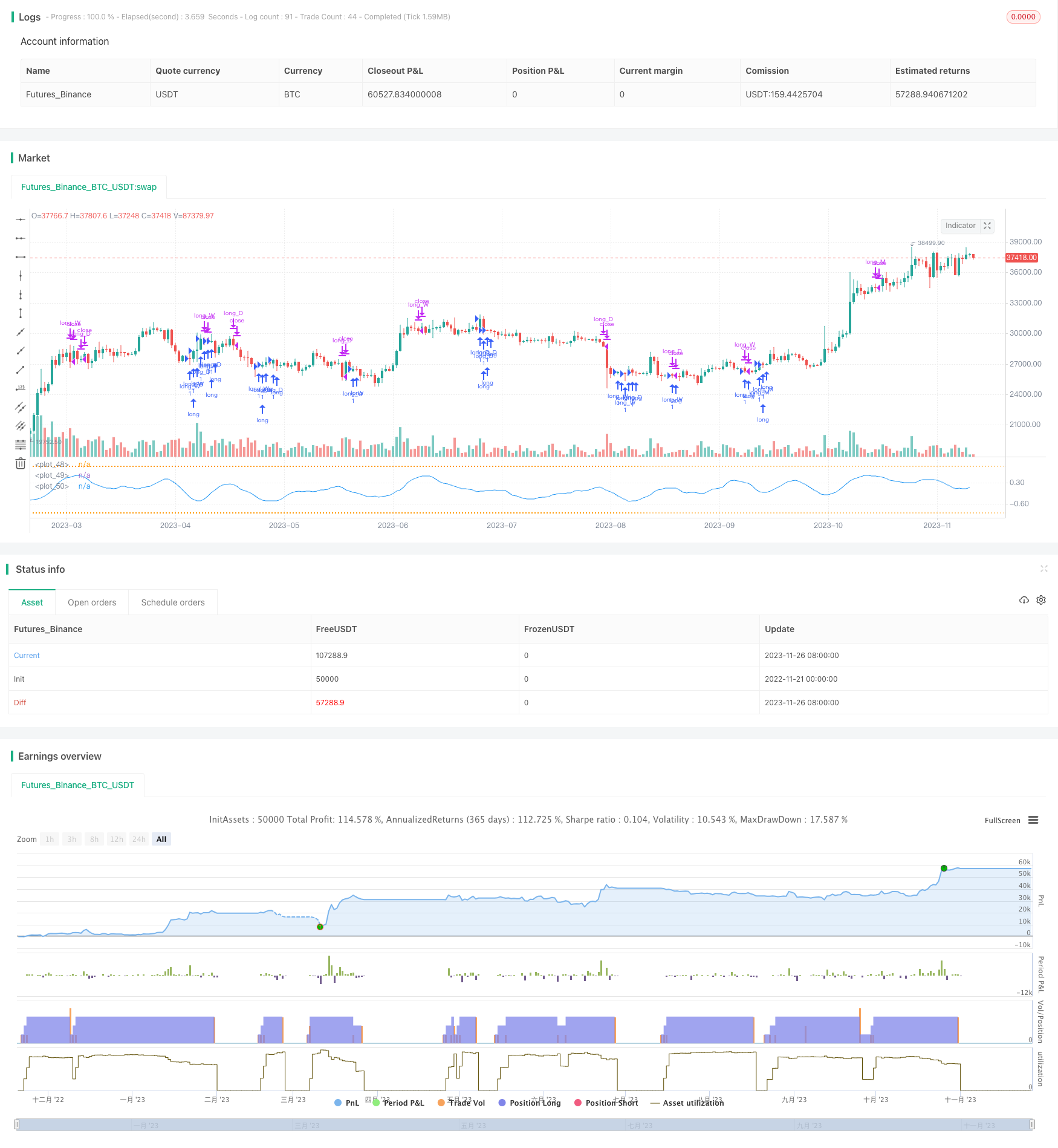
概述
P-Signal多时间框架交易策略是一种基于统计原理,结合多时间框架分析的数字货币算法交易策略。该策略运用高斯误差函数以及P-Signal指标对比特币的日线、周线和月线进行模型fit,根据指标金叉做多和死叉做空,实现波动率交易。
策略原理
P-Signal策略的核心指标是P-Signal,它结合了统计标准差和简单移动平均,通过高斯误差函数映射到-1到1区间,用来检测市场是否符合正态分布。具体计算公式如下:
fErf(x) = 1.0 - 1.0/(1.0 + 0.5*abs(x)) * exp(-x*x - 1.26551223 + ...) # 高斯误差函数
fPSignal(ser, n) = fErf((stdev(ser, n) > 0 ? sma(ser, n)/stdev(ser, n)/sqrt(2) : 1)) # P-Signal指标
该策略在日线、周线和月线时间框架分别计算P-Signal指标,当指标上穿0轴时做多,下穿0轴时平仓。同时设置指标值阀门控制重复开仓。
优势分析
P-Signal策略最大的优势是利用多时间框架提高策略稳定性。日线捕捉市场短期波动,周月线过滤假突破。同时,P-Signal指标本身也具有一定的预测能力,可以放大趋势性行情的波动。
相比单一时间框架,多时间框架可以在回撤时利用日线止损,而在震荡行情中利用高级时间框架减少交易频率。整体来说,这种组合可以在保证盈利的同时最大限度降低绝对和相对回撤。
风险分析
P-Signal策略最大的风险在于指标本身对量化交易员来说是一个黑箱。我们很难确定该指标对特定市场的适配度,也无法确定其参数的最优化范围。这可能导致在实盘中策略表现不佳。
此外,策略本身也存在一定的局限性。例如无法处理剧烈行情,指标差值作为交易信号可能滞后等。这些问题都可能成为实盘时的隐患。
要解决这些问题,我们可以调整指标参数,优化止损方式,引入更多辅助指标等。但前提是要在足够大的回测区间验证策略稳定性。
优化方向
P-Signal策略有几个可以优化的方向:
更换P-Signal指标的参数:nIntr_D、nIntr_W和nIntr_M,找到最优参数组合
增加止损方式:跟踪止损、时间止损、ATR止损等,找到最优止损方式
引入辅助指标:增强策略对特定行情的判断能力,例如引入MACD判断趋势
优化仓位管理:设置动态仓位,优化资金使用效率
机器学习优化参数:使用神经网络、遗传算法等寻找参数全局最优
总结
P-Signal多时间框架交易策略整体来说是一个非常有潜力的策略思路。它结合统计原理与技术指标,利用多时间框架分析提高稳定性。如果我们能够通过大量回测和优化解决部分局限性,完全有可能将其转化为真实可用的数字货币算法交易策略。
/*backtest
start: 2022-11-21 00:00:00
end: 2023-11-27 00:00:00
period: 1d
basePeriod: 1h
exchanges: [{"eid":"Futures_Binance","currency":"BTC_USDT"}]
*/
// **********************************************************************************************************
// This source code is subject to the terms of the Mozilla Public License 2.0 at https://mozilla.org/MPL/2.0/
// P-Signal Strategy © Kharevsky
// A good strategy should be able to handle backtesting.
// @version=4
// **********************************************************************************************************
strategy("P-Signal Strategy:", precision = 3, pyramiding = 3)
//
// Parameters and const of P-Signal.
//
nPoints_D = input(title = "Number of D Bars", type = input.integer, defval = 9, minval = 4, maxval = 100, group = "Parameters of observation.")
nPoints_W = input(title = "Number of W Bars", type = input.integer, defval = 4, minval = 4, maxval = 100, group = "Parameters of observation.")
nPoints_M = input(title = "Number of M Bars", type = input.integer, defval = 6, minval = 4, maxval = 100, group = "Parameters of observation.")
int nIntr_D = nPoints_D - 1
int nIntr_W = nPoints_W - 1
int nIntr_M = nPoints_M - 1
bool bDValveOpen = true
bool bWValveOpen = true
bool bMValveOpen = true
//
// Horner's method for the error (Gauss) & P-Signal functions.
//
fErf(x) =>
nT = 1.0/(1.0 + 0.5*abs(x))
nAns = 1.0 - nT*exp(-x*x - 1.26551223 +
nT*( 1.00002368 + nT*( 0.37409196 + nT*( 0.09678418 +
nT*(-0.18628806 + nT*( 0.27886807 + nT*(-1.13520398 +
nT*( 1.48851587 + nT*(-0.82215223 + nT*( 0.17087277 ))))))))))
x >= 0 ? nAns : -nAns
fPSignal(ser, int) =>
nStDev = stdev(ser, int)
nSma = sma(ser, int)
fErf(nStDev > 0 ? nSma/nStDev/sqrt(2) : 1.0)
//
// Signals for the strategy.
//
float nPSignal_D = sma(fPSignal(change(ohlc4), nIntr_D), nIntr_D)
float ndPSignal_D = sign(nPSignal_D[0] - nPSignal_D[1])
//
float nPSignal_W = sma(security(syminfo.tickerid, "W",fPSignal(change(ohlc4), nIntr_W)), nIntr_W)
float ndPSignal_W = sign(nPSignal_W[0] - nPSignal_W[1])
//
float nPSignal_M = sma(security(syminfo.tickerid, "M",fPSignal(change(ohlc4), nIntr_M)), nIntr_M)
float ndPSignal_M = sign(nPSignal_M[0] - nPSignal_M[1])
//
// P-Signal plotting.
//
hline(+1.0, color = color.new(color.orange,70), linestyle = hline.style_dotted)
hline(-1.0, color = color.new(color.orange,70), linestyle = hline.style_dotted)
plot(nPSignal_D, color = color.blue, style = plot.style_line)
//
// Multi Frame Strategy
// ... Day
if(nPSignal_D < 0 and ndPSignal_D > 0 and bDValveOpen)
strategy.entry("long_D", strategy.long, 1)
bDValveOpen := false
if(nPSignal_D > 0 and ndPSignal_D < 0)
strategy.close("long_D")
bDValveOpen := true
// ... Week
if(nPSignal_W < 0 and ndPSignal_W > 0 and bWValveOpen)
strategy.entry("long_W", strategy.long, 1)
bWValveOpen := false
if(nPSignal_W > 0 and ndPSignal_W < 0)
strategy.close("long_W")
bWValveOpen := true
// ... Month
if(nPSignal_M < 0 and ndPSignal_M > 0 and bMValveOpen)
strategy.entry("long_M", strategy.long, 1)
bMValveOpen := false
if(nPSignal_M > 0 and ndPSignal_M < 0)
strategy.close("long_M")
bMValveOpen := true
// The end.